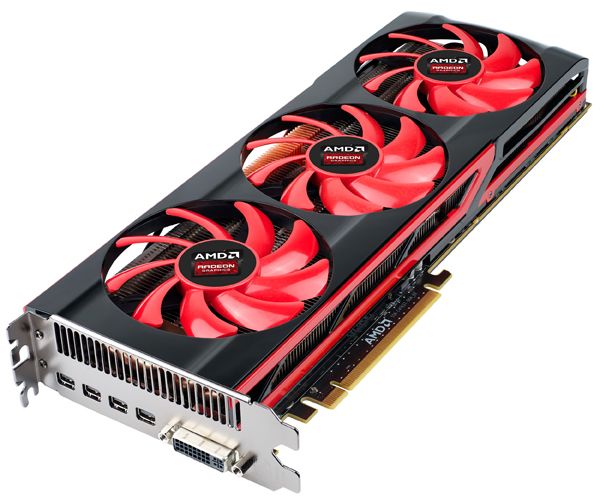Graphics Cards


Sources:
Titan:
https://images10.newegg.com/NeweggImage/ProductImage/14-121-923-03.jpg
AMD:
https://encrypted-tbn0.gstatic.com/images?q=tbn:ANd9GcROsfTIAKbU5dDDXgLWkhHBG6Hg6VJ3I2KG272L7xde4YdA8QHZ
What does it do?
A graphics card or graphics processor unit (GPU) is very
similar to a processor in that both are used to solved
arithmetic and logical problems. Where the two components
differ is in what types of logical and arithmetic problems
they are designed to solve. In terms of hardware, processors
usually have anywhere between one to eight cores whiles GPU's
can have hundreds of microprocessors. This allows GPU's to
carry out more tasks at once but only if those tasks are easy
and not too complex. This is where the graphics part of GPU
comes in. Typically, rendering a single polygon on a computer
is a trivial task in terms of computing power. One
microprocessor can handles this task with ease, but what if
the computer is told to draw a complex shape? One that
consists of multiple polygons?
GPU vs CPU
Lets define a shape with an arbitrary number of vertices,
edges, and faces. When a particular computer receives the
order to draw the shape, it tries to partition the shape in
such a way so that it can be drawn using three dimensional
triangles. Lets say the computer determines that two hundred
triangles must be drawn to render the shape. This information
is relayed to the GPU, which relays the information regarding
the specific coordinate location of each vertex, the vertices
that are joined by an edge, and the representation of each
triangular face to each microprocessor. The work is then
divided evenly across one hundred microprocessors meaning each
microprocessor is in charge of rendering two simple triangular
shapes. Since each microprocessor can work simultaneously
among the other microprocessors, the shape is rendered in two
iterations. Had the prior example been assigned to a processor
with four cores, it would have taken fifty iterations for the
shape to be rendered.
So if a GPU can handle more tasks at once, then what is the
point of even having a CPU?
A GPU is only more efficient when it comes to executing a
large number of simple instructions. On average, a single
microprocessor on a GPU is much slower than a core on a
multi-core processor. This means if an extremely difficult
problem is passed to one microprocessor on a GPU, it will take
a large amount of time for that single microprocessor to solve
it compared to the faster core on a CPU. In general, CPU's can
be thought of as the dedicated device that handles complex,
lengthy instructions while GPU handles abundant, simple
problems.
| What a CPU solves |
What a GPU solves |
Derive the general solution of the Laplace transform of t^5 * arccosh(at+ qt^b)*sin(ct)*e^dt using a series expansion blindfolded, in a loud room, with a jumbo sized Sharpie, on a 3x5 note card.
|

|
More Processes = More Power
While GPU's can be considerably faster than CPU's for some
tasks, they almost always take more power to function at an
effective speed. With the high end GPU's today like the Titan
X, power consumption is upwards of 250w while a high end Intel
i7 processor only takes 84w to function. In some cases, people
opt to put two GPU's in a single computer and bridge them
together in a scalable link interface (SLI). By having two
cards, the computer can share the processing load across two
GPU's making the computer faster but a lot more power hungry.
In particular, as discussed in the web page about processors,
heat becomes a major issue in this case because GPU's will not
be able to process data as efficiently when they are
overheated.
GTX Titan GPU's in Four-Way SLI

Calculating Cost
Lets say a computer running a Titan X is left on for five
hours each day for a year, how much does it cost to run the
GPU per year?
Price per KWh in Fairbanks = $0.2422/KWh
5 hours a day for 365 day = 5 * 365 = 1825 hours
So the price of running a Titan X five hours a day per year = $0.2422/KWh * 0.250KW * 1825h
= $110.5 per year
This is expensive machinery to maintain!
In the setup above, assuming each Titan X adds on an additional 250w to the total power, it would cost roughly:
$0.2422/KWh * 1KW * 1825h = $442 per year
Heat Expulsion
When dealing with a setup such as the one above, convection
currents and fans are essential steps in designing a
computer that can remove heat from multiple GPU's
effectively. Below is a diagram of a HAF-X case which
intakes cool air from the outside via fans located on the
top, front, and bottom of the case. This cool air is
directed towards the two GPU's in the bottom left hand
corner of the computer case. It is then intermixed with hot
air blown off by the fans on the GPU thus causing the heat
to be transferred from the hot GPU's to the cool air via
convection. As a result, the thermal equilibrium temperature
reached between the GPU and cool air causes the GPU to
transfer heat and therefore run more efficiently. It should
be noted that in many setups, it is typical to have as many
cold air intakes as possible and only one direction for the
hotter outtake air. This setup features a convection zone
border which is a fancy name for splitting the cooling
process across two sets of intake and outtake fans. This
helps ensure the cool air coming into the computer is having
minimum heat exchange with the hot air blown out of the
back.

Picture Sources:
multiplication table:
http://www.math-aids.com/images/multiplication-drills.png
4 way SLI GPUs:
https://content.hwigroup.net/images/products_xl/293029/3/nvidia-geforce-gtx-titan-x-sli-4-way.jpg
HAF-X:
https://www.dataimage.com/jpeg;base64,/9j/4AAQSkZJRgABAQAAAQABAAD/2wCEAAkGBwgHBgkIBw